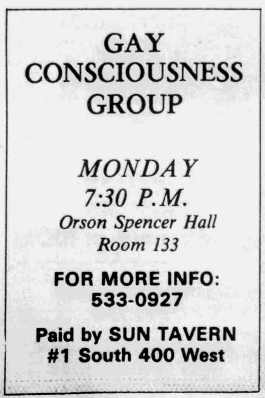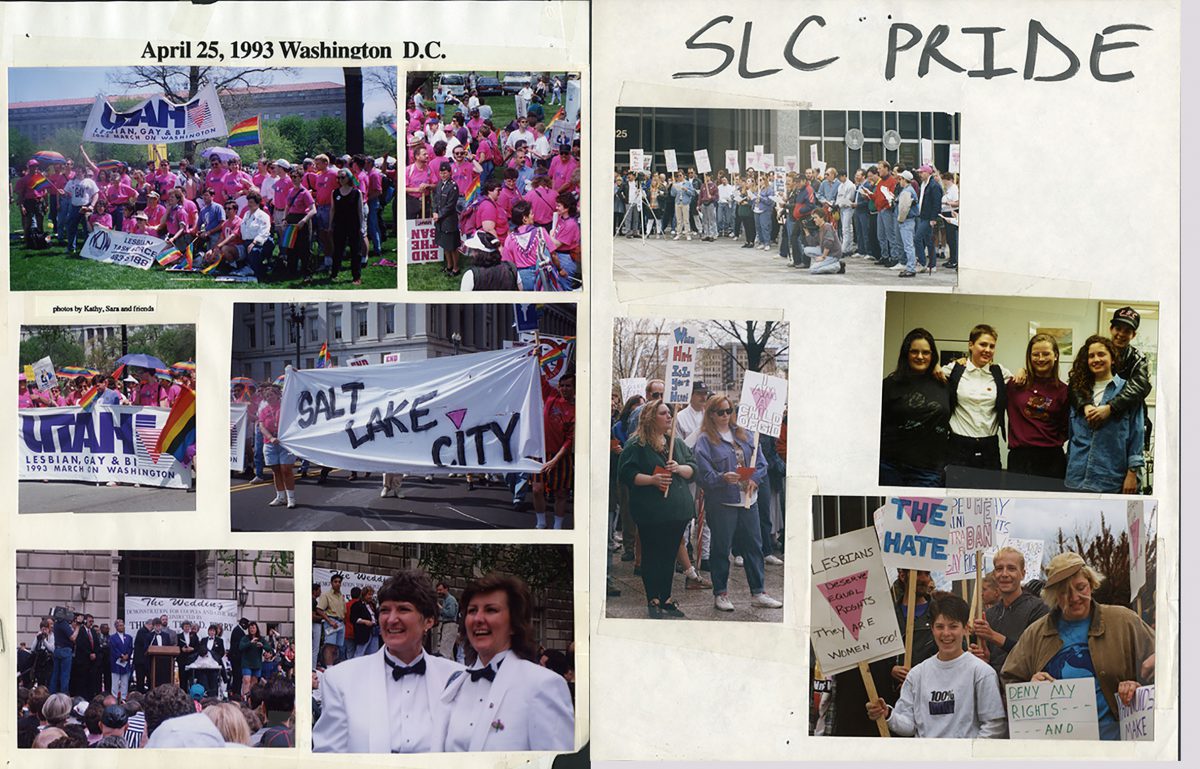Salt Lake West Side Stories: Post Thirty-Two
by Brad Westwood
Although the LGBTQ+ community had many prior informal political and social gathering spots elsewhere in Salt Lake City, a number of bars and taverns located in the Pioneer Park neighborhood served as a place to gather for Salt Lake City’s emerging LGBTQ+ communities.
In 1970, just one year after New York City’s Stonewall Riots sparked national gay and lesbian movements, Perky’s, which advertised as a bar for women but discreetly served Salt Lake City’s lesbian population, opened its doors on North Temple Street. Perky’s was eventually torn down to make way for the rebuilding of the I-15 North Temple overpass. The old west Salt Lake City was also the home of other LGBTQ+ gathering places, including the Rose Tavern opened in the early 1970s and whose name was eventually changed to the Rail; the Uptown opened in 1976 at 1500 South and 400 West; Studio 8 opened during the mid-1970s at 800 West and 200 South; and the Comeback Club opened in 1977, located at 551 South and 300 West, which also became a popular gathering place for members of Salt Lake’s LGBTQ+.
Like other established communities, the Pioneer Park LGBTQ+ peoples have also had various publications including the longest-running LGBTQ+ newspaper The Pillar (1993-2007).
“The Pioneer Park neighborhood welcomed LGBTQ+ people, but it is important to note that it was the only area where Salt Lake City citizens and Utahns allowed such places to openly exist.”
The Pioneer Park neighborhood welcomed LGBTQ+ people, but it is important to note that it was the only area where Salt Lake City citizens and Utahns allowed such places to openly exist. Well into the twentieth century, the city police closely surveilled gay and lesbian bars and taverns.

Utah’s first openly gay bar, Sun Tavern, opened its doors in 1973. Located on the northwest corner of South Temple and 400 West, the “Sun” became a de facto gay community center for the then publicly emerging community. Sun Tavern’s founder and proprietor Joe Redburn, an openly gay man, organized Utah’s first gay festival and public gathering, which took place in 1974 on the fifth anniversary of the Stonewall Riots. Sun Tavern remained for many decades one of Pioneer Park neighborhood’s hotspots. For example, one of the best-known and publicized arrests took place at Sun Tavern in 1978, when Hollywood Squares TV show regular comedian Paul Lynde was arrested for disorderly conduct. Initially, Lynde called Salt Lake City police to report that someone had broken into his car and stolen his briefcase and $1,000 in cash. A Salt Lake City police officer chose to arrest Lynde instead for public intoxication rather than investigate his legitimate robbery. At the time of the arrest, the comedian was in Utah to tape an episode of “The Donny and Marie Show,” at Osmond Studios at the mouth of Provo Canyon in Orem, Utah. After this story became public, the show’s producer voided Lynde’s contract. While the Pioneer Park neighborhood became a place for LBGTQ+ citizens to gather, discrimination was a constant factor in their everyday lives.
The history of LGBTQ+ Utahns extends far beyond the boundaries of the Pioneer Park neighborhood. Today, with a prominent voice in Utah’s public life and politics, Salt Lake City’s LGBTQ+ communities are one of the nation’s most successful in their quest for acceptance. A recent Salt Lake Tribune article describes Utah as one of the most conservative and religious states in the union and as a state with some of the nation’s best legal protection for its LGBTQ+ citizens.
Thank you for reading this post about members of Salt Lake City’s LGBTQ+ peoples and businesses. We hope that you join us for the next Salt Lake West Side Stories post about modern life in the Pioneer Park neighborhood.
Would you like to read the next post (post 33)? Current Challenges and Developments in a Post-Industrial Neighborhood: Part One
Click here to return to the complete list of posts.
Related Activities:
Listen to this Speak Your Piece podcast (two 30-minute segments) with historian J. Seth Anderson, who offers the story of LGBTQ+ peoples in Salt Lake City during the last fifty years. See Speaking About Utah’s LGBTQ+ History.
Regarding LGBTQ+ newspapers in Salt Lake City, including The Pillar, see Brian Robles’ “Printed Voices of the Salt Lake City LGBT Community in the Early 1990s,” in Utah Communication History Encyclopedia (a Brigham Young University-based publication).
Contributors: A special thanks goes to J. Seth Anderson and Babs Delay for offering insights and content for this post.
This post was researched and written by Brad Westwood with a whole lot of help from friends. Thanks to our sound engineer and recording engineer Jason T. Powers, and to his supervisor Lisa Nelson, both at the Utah State Library’s Reading for the Blind program. Thanks also to yours truly, David Toranto, for narrating this post.
Selected Readings:
Seth Anderson, LGBT Salt Lake City (Charleston: Arcadia Publishing, 2017).
“This Day in Gay History, September 9,” Utah Stonewall Historical Society Archives (blog), September 9, 2013.
“Paul Lynde Arrested,” The Daily Item, January 12, 1978, 118.
Babs Delay, “Gay Ol’ Utah, Being LGBT in a red state Doesn’t Have to Give you the Blues,” Salt Lake City Weekly, February 18, 2013.
Courtney Tanner and Scott D. Pierce, “Utah Ranks 2nd in Nation for Supporting Laws that Protect LGBTQ Community,” Salt Lake Tribune, July 22, 23, 2019.
Do you have a question or comment? Write us at “ask a historian” – askahistorian@utah.gov

